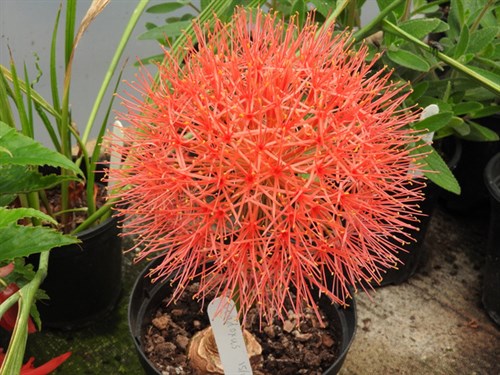Phew - what a scorcher, Mediterranean weather in West Wales
Wednesday, August 1, 2018
3 consecutive summer months, each getting better than the
last. The gardens here look better than I would ever thought
possible given the lack of precipitation we have had, and some of
the highest temperatures we have ever had at Cilgwyn in 42
years.
Exuberant planting in the Paddock Garden.Phlox, lilium
leichtlinii,hydrangea paniculata, buddleja and
thalictrum
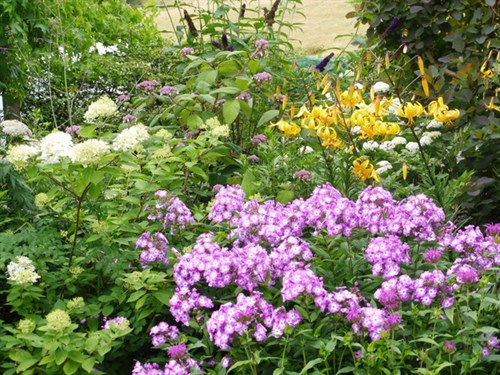
The house garden on fire with hydrangeas paniculata and
GeneraleVicomtesse de Vibraye highlighted by crocosmia
masonorium

I am hoping that unlike the June News, when I thought I had lost
most of the pictures loaded into files to incorporate them into the
text of News, there will be plenty of pics to convey what a great
month it has been. Without doubt, aside from the magnificent
flowering of a wide range of plants, the highlight of the month was
the visit of BBC "Gardeners' World" which at the time of writing
has not yet been broadcast. As soon as I know the date I will let
you know. With a special News update
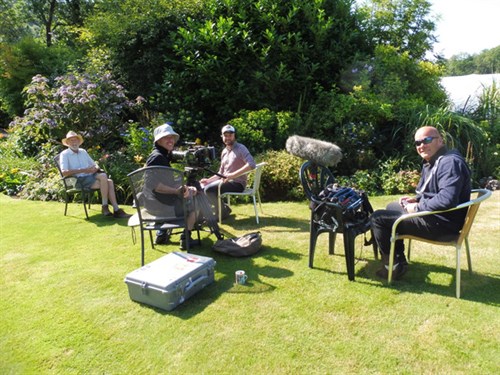

Weather
Like most parts of the UK each day seems to have
been a replica of the last and I don'think I have ever been so
brown or worn shorts so often! It was a real tonic and made me feel
so much better after the treatment I endured during the Winter and
Spring which still continues to give me side effects but doesn't
prevent me from being physically active most days.
There were 25 days of sunshine, max 28C on 7th (We didn't quite
beat 30C) and only 3 rain days and 4 days of changeable
weather. The fine weather broke on 28th with torrential rain
on and off and brighter interludes.there was one and a half inches
of rain overnight and early morning on the Sunday.Great for the
parched gardens but not for us!
Digging a hole to plant out a stock plant shows how dry
the ground is. A crow bar was required!
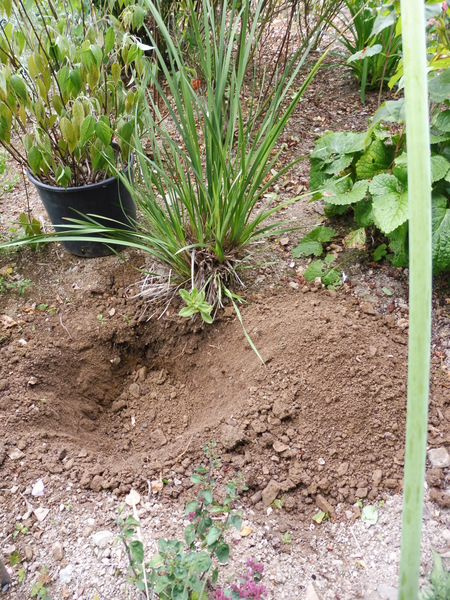
Wales looking like somewhere in
Provence!!
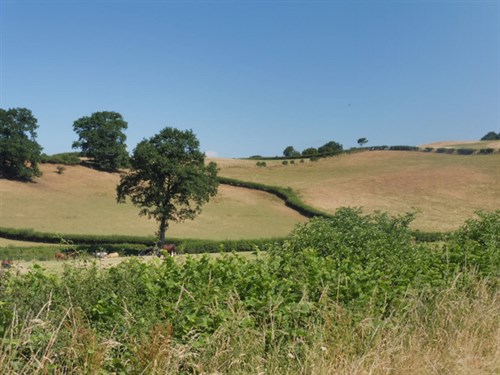
Having had so much clear and sunny weather I was hoping that for
once a cosmic event could take place without any cloud cover. On
27th there was an eclipse of the moon during which time the moon
was due to turn red but apart from TV coverage that was about all I
saw, until at just after 2.00a.m. the clouds cleared and I had
brief impression of a vaguely pink sky and some turbulent clouds,
better than nothing I suppose but the main event it wasn't!!

The next evening it was a true pink
sky

Garden Update
Watering has been a major task throughout the month, not
only all the protected areas. but most of the borders where I
had recently planted out all my overwintered salvias and new
plant purchases which had seduced me!!. The plant nursery trade
have reported a fall off in plant sales during July as prospective
purchasers have avoided buying new plants whilst the heatwave and
drought continued.
After a slow start in April and early May, in sowing and
planting out of vegetables, they have caught up wonderfully well
and almost all vegetable varieties are well ahead of where they
usually are during July.
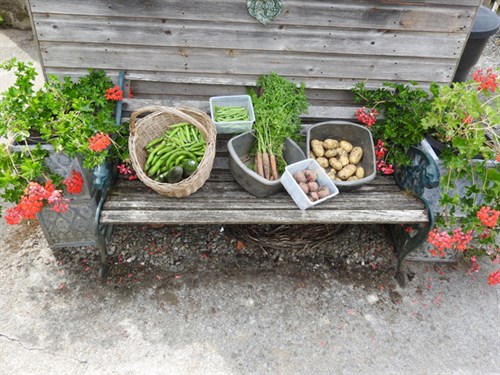
This is especially true of sweetcorn which has produced some
fine cobs with up to three a plant. The tassels are already
dry and brown usually a sure sign that they are ready to
harvest, but peeling back the husks has not yet revealed any ripe
cobs.

The veg plot has had regular watering producing a good crop of
quite large potatoes from the salad types Charlotte and
Venezia, which are all we grow now. I promise you Venezia is
the best tasting, waxy, golden yellow potato you will ever
experience It is impossible to overcook it and it never
turns black when cold. For me it leaves the much heralded
Jersey Royals in the shade
Burried Treasure. Digging the first spuds of the year is
always exciting - what sort of crop do we have?
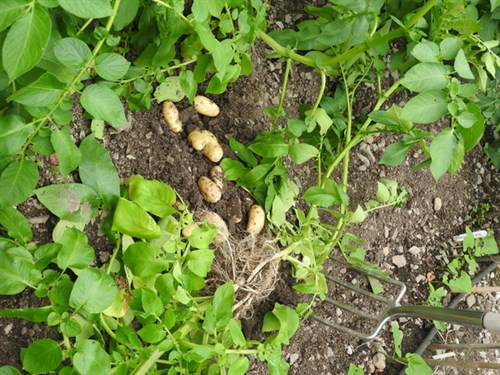

This summer goes to show that whilst you can't create the
sort of warmth that we have had, you can replicate moisture by
regular irrigation which creates the perfect environment for all
manner of plants to perform to their best. So more summers like
this one please, and reliable water suplies provided,
there are no hosepipe bans. The sheer scale of the garden
here makes it impossible to water everything, and a few shade
loving plants like ferns and some hostas have really struggled and
turned brown. It will be interesting to see how they recover when
the rains come. The same is true for the hellebores in dry
shade
It is just as well that I have had the time for all the extra
work entailed in watering, freed up by the huge reduction in lawn
mowing now that most of the grass has stopped growing with large
brown patches brown patches. As you know I love a perfect
green sward, but not at the expense of watering the lawns which can
be counter productive unless you have unlimited supplies. It can
also make the roots of the grass grow upwards, the surface being
where most of the water will end up, and make the condition of the
lawns get worse.
One place where there is still plenty of water is the Paddock
pond and one of the most pleasant jobs on a hot day in chest
waders, is to enter the pond to remove the surpless pond weed that
simply revels in these conditions and whilst I am about it, to cut
off all the discoloured and dying water lily leaves and dead
flowers which look unsightly. The fish love the clearer water which
makes it easier to see them. The pond is currently full of fish fry
from the spawnings in May and June.
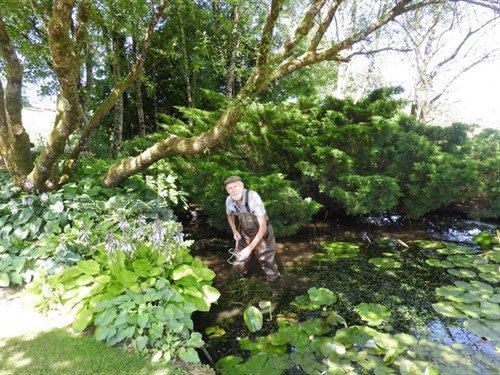
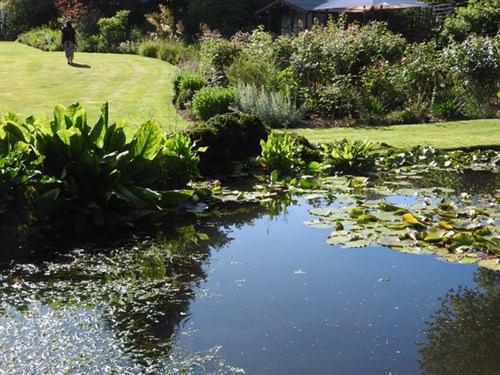



Damsel fly Blue Demoiselle in early
June


One of the downsides of a very clear pond is that it
attracts a range of predators, this heron looks like it has a
yellow crown on its head courtesy of a yellow
mimulus!!

Pests and diseases have made the most of the fine weather,
whitefly being everywhere, in particuar the tomatoes in the large
tunnel. The encarsia wasps, natural defenders which I applied
earlier in the year, have had no effect whatsoever. so it will be
back to yellow sticky cards or insecticides.
Poor old tomatoes are having a hard time of it because
blackbirds have taken a liking to them. They take the bite sized
smaller varieties straight from the plants, but the standard sized
fruit are more of a challenge; with these they just peck at them,
or knock whole trusses from the plant and devour them on the
ground.

The blackbirds have lately transfreed attention to the maturing
sweetcorn cobs. You have to admire their ingenuity but not at the
expense of a precious summer crop. Capsid bugs are a perennial pest
damaging leaves and energing flower buds of a wide range of host
plants including hydrangeas, dahlias, fuchsias, brugmansias and
even potatoes. There are a range of pesticides available to control
them. Some good news is that the hemerocallis gall midge did not
persist very long and most hems are now clear with no treatment.
And there was a time in June when I was alarmed at the first
sightings of lily beetle which we have never had here before, but
that too disappeared except for a minor infestation a month ago on
lilium pardilinum at the back of the Paddock pond. And finally
clouds of cabbage white butterflies have been on the wing
throughout the hot weather, decimating even the brassicas
under cover of horti fleece which they seem able to avoid through
smll holes in the fleece.
And there is always the prospect of clubroot rearing its
ugly ahead in the brassicas, in this case swede. Just time to make
one more sowing for the winter. There is no effective treatment
aside from regular yearly liming
h
What's looking good?
So much that pics are the best way to show the very
best.
Top of the bill are hydrangeas, 62 plants of which are scattered
throught the gardens. Having had some concerns earlier what the
impact of the unseasonably late frosts and "The Beast" were going
to have on them as late cold winters did in 2 previous years.
But fortune smiled on us and they have been exceptional.
There was no evident damage as the result of any adverse low
winter temperatures In fact those stuated in the most open and
sunny situations and relatively well drained soil did show some
limited signs of scorching of leaves but the flowers have remained
intact. With so many of them the impact on the gardens is quite
devastating if many of them fail to flower as the result of late
frosts when the flower buds are forming.
The star performer has been this marvellous example of
h. aspera subsp.sargentiana which is always smothered in honey bees
from the local hives
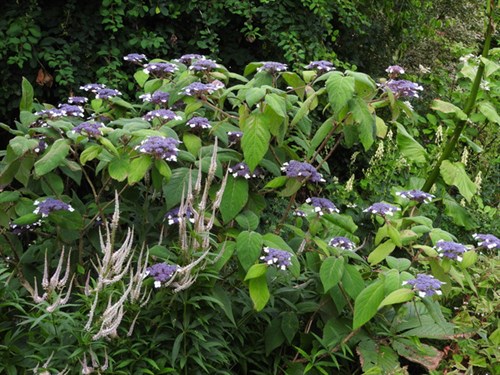
Hydrangea paniculata "Vanille Fraise" is so
appropriately named with flowers of cream and pink - a bit "girlie"
perhaps but a masssive impact in the summer borders
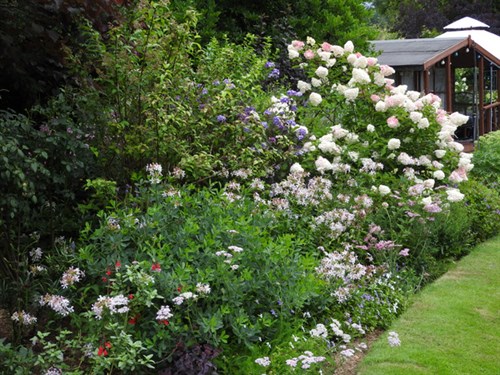
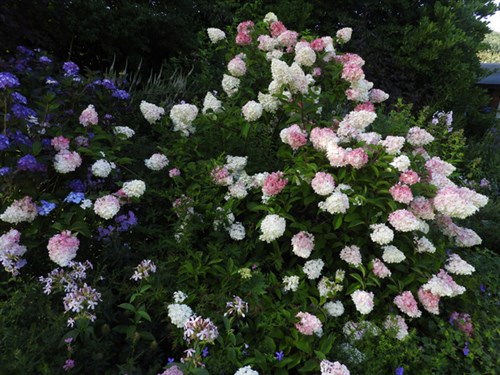
More muted forms of hydrangea paniculata with, in the
foreground, one of the many phlox in the garden, a much admired red
form "StarFire"
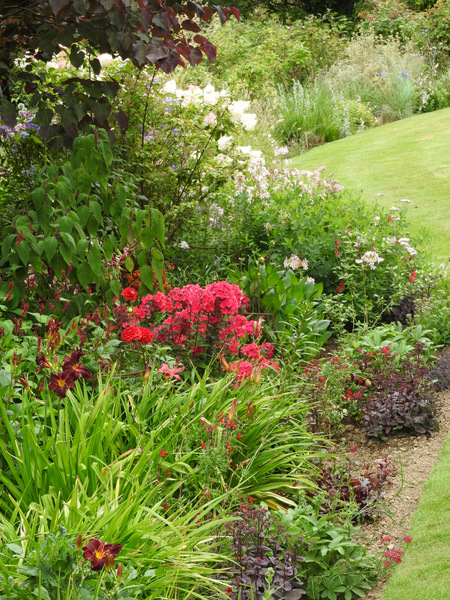
Hemerocallis are still flowering well in a good
range, one of my all time favourites is this delightful form which
came to me as one of my first hems called Vespers but the
current edition of the RHS Plant Finder does not list this form.
Searches on the internet did not reveal any conclusive pictures to
confirm the name. Who cares?!! it is a lovely floriferous
plant with choice flowers and a delicate perfume
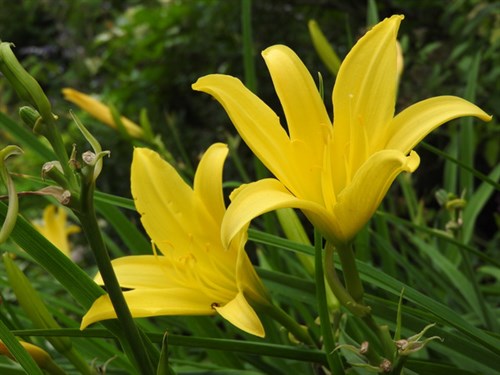
Several years ago I sowed hem. seed donated by
members of the American Hemerocallis Society which were a
range of crosses they had made, in a variety of forms and colours.
It was really exciting when up to 4 years later they began to
flower, this spider form has huge flowers up to the size of
an adult hand

A true wild hem and long established plant at Cilgwyn
Lodge is h. fulva in the double form. Still garden worthy in my
opinion
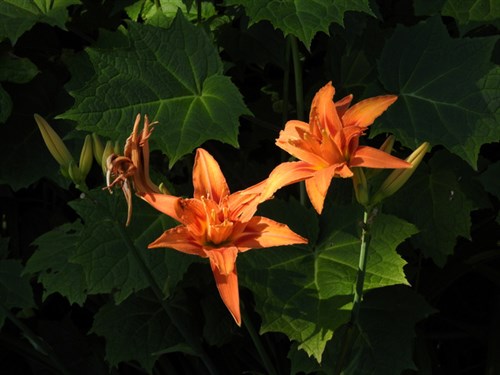
Lifting the shady area outside the conservatory are a
range of large tender plants like brugmansias and lilies not only
beautiful to look at but highly scented too. Kept in huge pots year
round and rotated with others as the summer goes round
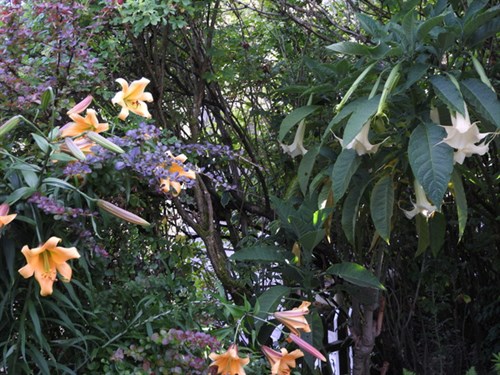
Another fine lily in the Red Border which has
bulked up very well over the years is l. "Black Beauty" at 5 feet
tall

A recent introduction is l. "Kushi Maya" which is a
cross between l nepalense and a large flowed form and highly
scented.
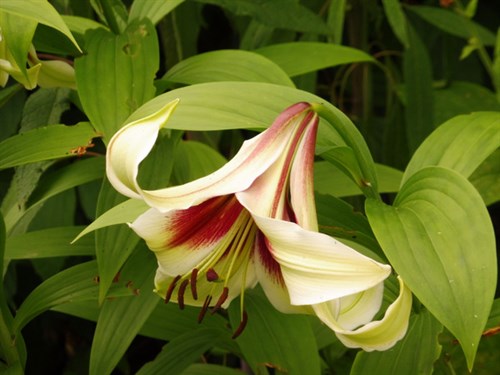
Revelling in the hot weather are agapanthus in the Koi
Pond Border many of which I have grown from unknown
seed.
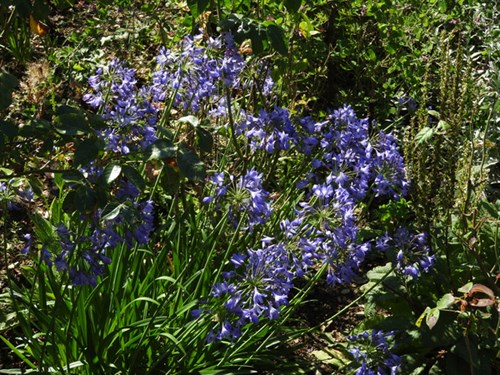
A new introduction this year is Senecio "Angels Wings"
an unbelievable silver foliaged plant for sunshine and good
drainage
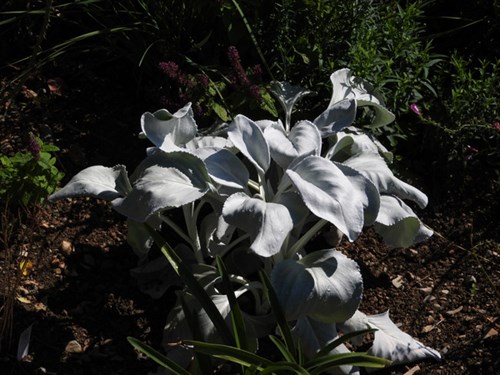
When planted in close harmony with drifts of artemesia
it creates the just the sort of image so beloved of Gertrude
Jekyll, the flow of the 2 plants bringing together other members of
the border plantings.
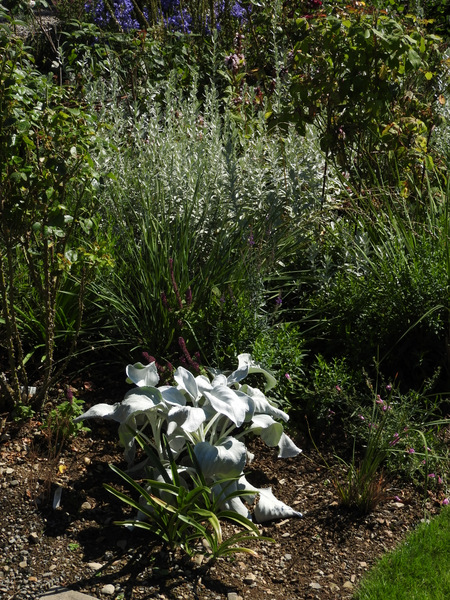
Crocosmias "Pauls Best Yellow" and
Masonorium

With such a range of hardy geraniums to choose from
there are always new ones to choose from, my latest being "Cristal
Ice"
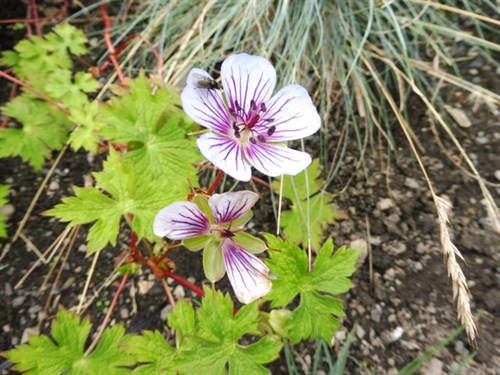
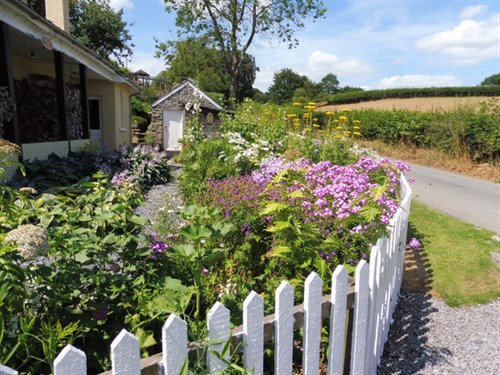
Wildlife and countryside
Swallow numbers have increased considerably and why wouldn't
they when there are so many insects to feed their offspring. On a
larger scale red kites are always in evidence over the Lodge and if
you want to see them at closer quarters just a few miles away is
The Red Kite Feeding Centre where the birds are fed in the
afternoon.

Close up, especially when set against a cheeky
magpie, you can see what large and powerful birds they
are.
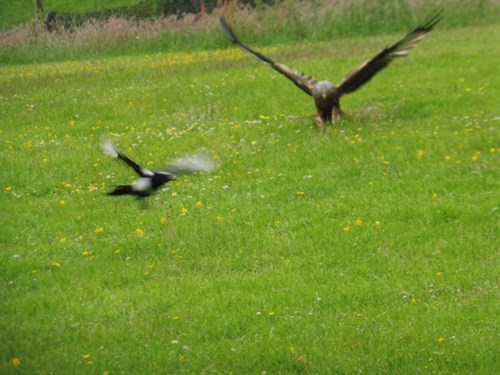

On the subject of insects there have been masses of dragonflies
and damsel flies but not so many butterflies as you might have
expected, except of course the dreaded cabbage white
One insect I have been looking forward to seeing for the first
time since 2006, is the humming bird hawk moth which seems to be
particularly fond of deep throated salvia flowers which we
have in increasing numbers as the summer progresses. I often see an
adult hedgehog in the large tunnel along with a baby one, both
finding a comfortable bed in a pile of horticultural fleece under
the staging.

The surrounding countryside is parched and unnaturally brown and
some hedgerow trees are beginning to show signs of substantial
stress as the leaves become scorched and continue to fall. In some
cases it is disease that causes this, either ash dieback or sadly
the resurgence of Dutch Elm Disease closer to home with one long
established Wych elm along the garden boundary which was showing
symptoms this time last year.
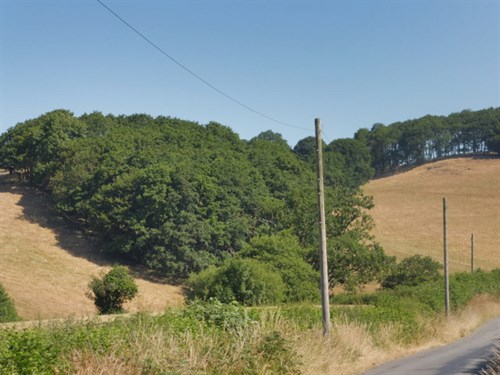
On the farms with the grass harvest all but taken, there is
precious little grass for grazing and our neighbour Alun has had a
hard time of it taking his livestock from field to field to share
out what grass there is and have access to to the river which
fortunately is still flowing.
These clever sheep lined up in the mid day shade of a
field hedge with one that chooses to stay in the sun - must be a
mad dog of an English sheep!! I can say that being
English!
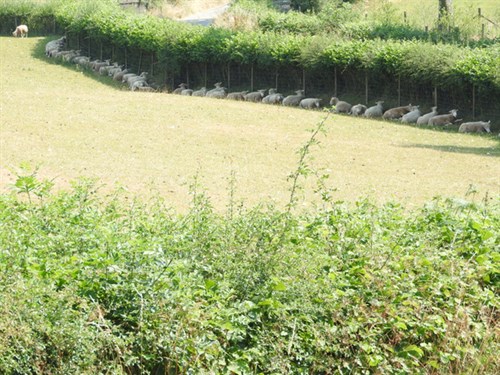
Visits
Because of all the work there is to do we haven't had many trips
out, but recently we did manage to get away when a neighbour
treated us to a short break at a hotel in Buckinghamshire;
Hartwell House, www.hartwell-house.com in
which he has an interest. A superb house in 90 acres with excellent
facilities and accommodation. It was a genrous and kind
gesture on his part and a very enjoyable change of scenery as we
were pampered and very well fed and watered!



And hanging on the wall of one of the elegant
rooms was this lovely verse
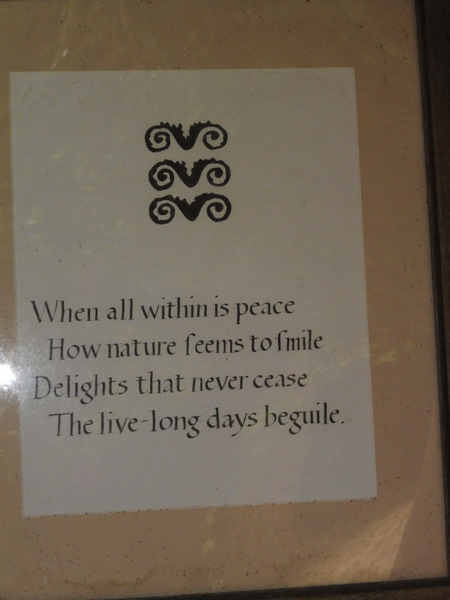
Closer to home in Pembrokeshire is Glyn Bach the
large garden of friends Peter and Carole Whittaker. They hold a
Plant Heritage National Collection of Monardas which
even on a very soggy day still managed to lok radiant - just like
Pete and Carole!
To find out more about this fascinating garden and
visiting arrangements go to www.glynbachgardens.co.uk


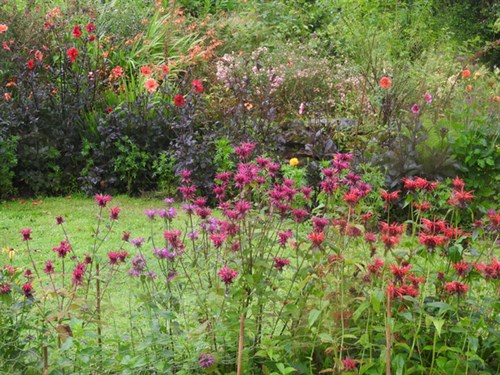
Of all the many alluring monardas in the
Collection my favourite, shining out like a beacon on such a dull
day, was m."Lederstrumpf" a German cultivar which Carole told
me translates as Leather Trousers!
honestly!!


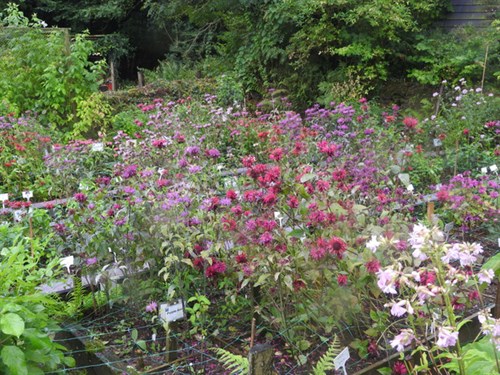
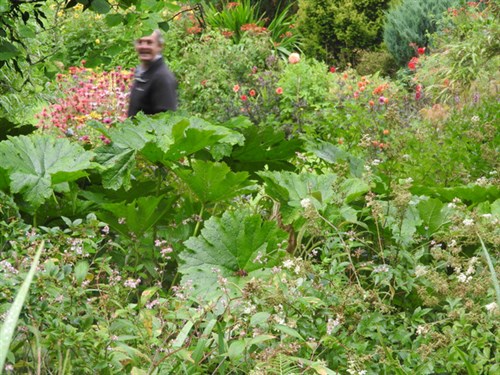
After completing such a marathon news item in which I am
hopefully making up for my poor offering in June, I went down to
the large tunnel where this incredible flower of the bulbous plant
Scadoxus multiflorus had just opened, like some form of laser
light. Incredible.
Good wishes to you all and try to catch up with our
feature on BBC "Gardeners' World" and look out for confirmation on
this website of when this will be shown.
